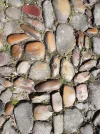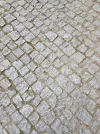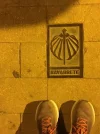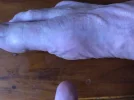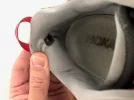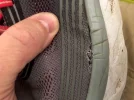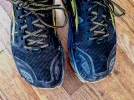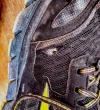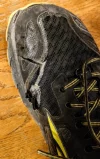I am going to do a bit of a hijack of your post

The Hokka One One Bondi 5 was replaced last year by the Bondi 6. Having used both, I find the improvements to the 6, while minor, make the Bondi an even better shoe.
I also want to make a minor point of distinction in order to help clarify the Bondi's function. Now, I use the Bondi as the shoe I wear backpacking and also on Camino, so I am not at all trying to discourage its use for such activities by sorting thru definitions.
The Bondi series are designed primarily as running shoes rather than as a trail runner or a trail shoe. The distinction defines both the feature set, build, and construction of the footwear. The Bondi does not incorporate those things that are particular to a trail runner or trail shoe.
1. Running shoes are designed for runners whose primary paths are largely hard packed or paved. They generally incorporate a bit more and firmer cushioning, and the outersole is usually not specifically designed with an aggressive tread. The uppers are constructed from lighter duty materials, and the overall design is to achieve as much lightness to the weight of the shoes as possible.
2. Trail runners / trail running shoes are designed to provide more protection for a runners' feet. It does this most frequently with the addition of a 'rock plate' which is usually embedded between the outersole and the midsole. This is needed because unlike road running, trail running involves, well, running on trails with its associated pokey stuff like rocks, roots, debris, etc. Another major distinction is a beefier structure to help with stability and motion control under rugged conditions. The third major characteristic is that they are equipped with much more aggressive tread patterns so that they can grip the trail and reduce the risk of slipping.
3. Hiking shoes. These are designed around the basic model for hiking boots. The materials are usually much 'beefier' and less flexible to the foot. This means that of the three types of shoes, they are much heavier and benefit from a prolonged break-in period. The outersoles a usually much thicker than the other two shoes types. While the structure of the shoe is stiffer, it doesn't add better stability or motion control.
Running shoes and trail runners require virtually no break in. How they feel out of the box will not substantially change with use. Wearing them will develop a 'memory' for the foot as it sits on the insole, and some minor changes to the upper on the outside of the feet may occur. Because they are lighter than hiking shoes, there is less energy use and fatigue potential to the walker.
Unlike stiffer and less flexible material like thick fabrics and leather, these shoes it will not become substantially 'molded' in the manner that one associates with traditional hiking boots. Hiking shoes, however, MAY benefit from a 'break-in', but in a far shorter period of time than traditional hiking boots.
Because the fit of the running shoe and trail runner is not subject to break in, it is important that they feel and fit well when purchasing them; they will not get 'better' with more wear. What many folks associate as a runner or trail runner 'breaking in' is actually the wearing out of the materials as they fatigue.
As I wrote above, I use my Bondi's as a trail runner even though they are a road running shoe. They do not have a rock plate, but they don't need one; the plush cushioning isolates the trail debris from the sole of the foot.
The tread is not the aggressive, deep-lugged outersole. But what I have found is that they are 'grippy' enough to provide excellent off-road traction. Part of that is how Hokka incorporates a type of micro-siping in the tread. . . . miniature, thin slits. These slits actually open a bit with each step on the ground which, in effect, creates hundreds of micro-edges that are biting into the trail surface.
I was exceedingly skeptical of the Bondi's ability to be a trail shoe, but after a lot of testing they are now my favorites. My own subjective assessment of foot aches and fatigue after 20+ miles of walking or hiking is that the cushioning markedly reduces how uncomfortable my feet feel.
That I find the Bondi a great trail shoe does NOT mean that anyone else will. I suggest it as one of several shoes to consider, but what I like is not a universal given for others.
